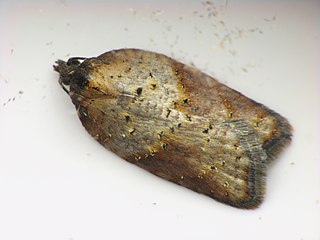
Oenosandridae is a family of Australian noctuoid moths. Genera include:

Chilo phragmitella is a species of moth of the family Crambidae, sometimes referred to by the vernacular names wainscot veneer or reed veneer. It was first described by Jacob Hübner between 1805 and 1810 as Tinea phragmitella, and is the type species of the genus Chilo.
Razowskiina is a genus of moths belonging to the family Tortricidae.
Seticosta is a genus of moths belonging to the family Tortricidae.

Eccopsis is a genus of moths belonging to the subfamily Olethreutinae of the family Tortricidae.
Archipimima is a genus of moths belonging to the family Tortricidae.

The Atteriini are a tribe of tortrix moths.

The Tortricini are a tribe of tortrix moths.
Marasmarcha samarcandica is a moth of the family Pterophoridae. It is known from Russia and Kazakhstan. Its habitat is chalk and desert steppes and semideserts.
Agriphila dalmatinellus is a species of moth in the family Crambidae that is known from Europe and Asia. Within Europe, it is found in Croatia, Bosnia and Herzegovina, Italy, Bulgaria, the Republic of Macedonia and Greece. In Asia, it is known from Cyprus, Iran, Iraq, Syria and Samarkand.
Idolatteria ops is a species of moth of the family Tortricidae. It is found in Peru.
Galomecalpa meridana is a species of moth of the family Tortricidae. It is found in Venezuela, Ecuador and Peru.
Stictea ejectana, the guava bud moth, is a moth of the family Tortricidae. It was described by Francis Walker in 1863. It is found on Fiji, Samoa, the Marquesas Archipelago, Tahiti, Rapa Iti, the southern Mariana Islands, the Philippines and in New Caledonia, New Zealand and Australia.
Orthocomotis chlamyda is a species of moth of the family Tortricidae. It is found in Venezuela.
Seticosta niveonigra is a species of moth of the family Tortricidae. It is found in Venezuela.
Phalonidia remissa is a species of moth in the family Tortricidae. It is found in Cuba.
Nkandla is a genus of moths belonging to the subfamily Tortricinae of the family Tortricidae. The genus was erected by Józef Razowski and John Wesley Brown in 2009.
Panegyra metria is a species of moth of the family Tortricidae. It is found in Ghana.
Paraccra mimesa is a species of moth of the family Tortricidae. It is found in Kenya and Tanzania.
Plinthograptis ebogana is a species of moth of the family Tortricidae. It is found in Cameroon and Ghana.






